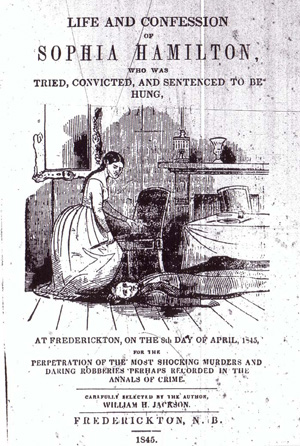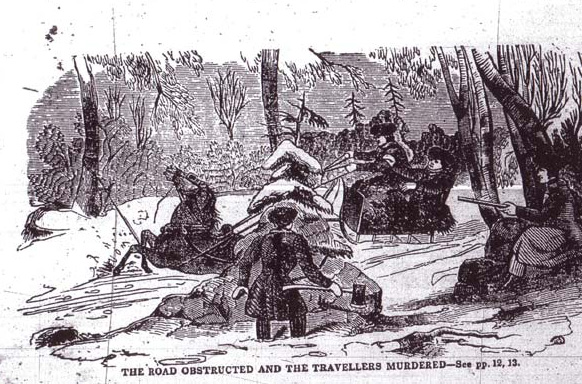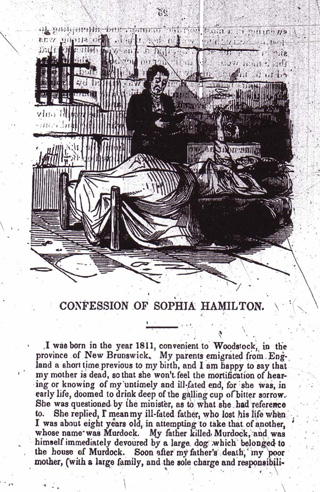Sophia Hamilton
"True" crime?
 In the 19th century, female murderers were rare - female multiple murderers even more so. The most common form of homicide involving women was infanticide, often carried out by young, unmarried women. As with today's society, women were much likely to be the victims as the agents of spousal homicide.
In the 19th century, female murderers were rare - female multiple murderers even more so. The most common form of homicide involving women was infanticide, often carried out by young, unmarried women. As with today's society, women were much likely to be the victims as the agents of spousal homicide.
In 1845 William H. Jackson published a pamphlet that supposedly detailed the foul deeds of the province's worst mass killer, a woman named Sophia Hamilton. According to the author, Hamilton was hanged at Fredericton, the colonial capital, on April 8, 1845, for having committed "the most shocking murders and daring robberies perhaps recorded in the annals of crime."
Jackson's pamphlet, despite its 'true crime" tone, is based on fiction, not fact. No such crimes took place in New Brunswick at this time. We include this case for cautionary purposes: historical researchers should first attempt to assess the authenticity and context of all sources before beginning to analyze them.
In Jackson’s narrative, Sophia was the youngest daughter of William Jones, allegedly the only son of a wealthy English aristocrat, and a "woman of low character." After spending his inheritance in riotous living, Jones and his wife emigrated to New Brunswick in 1811. Opening a store and tavern on the Fredericton-Woodstock Road, Jones became involved in smuggling across the Maine border.
Fearful of being exposed, Jones and members of his gang murdered an honest neighbour, but the ringleader was killed by the victim’s dog. Sophia’s mother relocated to Lower Canada, where she operated an inn near Montreal. Sophia at 17 married Hamilton, a respectable mechanic from Kingston, Upper Canada. After the suspicious death of her young husband, Sophia became "one of the most abandoned and notorious women," a path that led to robbery and murder.
Her crimes were carried out from Woodstock, NB, to where she located in 1834. Her inn attracted "quality" guests but she organized a criminal gang which specialized in ambushing, robbing and murdering travelers. A few years later Hamilton moved to the outskirts of Fredericton, where she personally murdered a wealthy businessman from Maine and a slave owner from South Carolina, as well as a servant boy who had witnessed the second killing. A number of her alleged murders involved poisoning, often depicted in literature as a women’s crime.
Jackson's account of Hamilton's crimes stresses that she was mainly motivated mainly by greed, not personal animus, but that her immoral and violent activities reflected more of a masculine than feminine persona.

Source: The Life and Confession of Sophia Hamilton.
Confession of Sophia Hamilton
According to Jackson's pamphlet, he visited the prisoner in the York County gaol after the trial and sentence of death; once she was told that there was no hope for a reprieve, she allegedly had taken poison, supposedly smuggled in by a person who feared being blackmailed by Hamilton. In her death throes, Hamilton supposedly confessed her crimes to a Methodist minister. She describes poisoning her husband over a 32-month period, and strangling her baby:
I wish that my name, and the memory of my cruelty, may be forever engraven on the memory of those who forgive me, or hear of my cruel life and miserable death, that it may be a warning for those entering on the path of life, that they may suppress the human passion, and untie the strong holds of Satan, who was my daily companion through life.
I am guilty of ten deliberate murders with my own hands, and accessory to many more. I will not confess to any more, for I do not, nor cannot expect forgiveness, for I already feel the wrath of an avenging God searing my soul- for my crimes are too black, my deeds to heinous, to expect to reign in happiness with those innocent beings that I caused to leave the world by cruel treachery; the tears of the bereaved widows, and the cries of the helpless orphans, will speak with tongues of indignation against me.

Source: The Life and Confession of Sophia Hamilton.
The author warned readers that the tale was proof that "an artful mind, actuated by illusion if not unchecked in youth, may pass on to acts of fraud and violence, and in some instances to deliberate and cold-blooded murder."
Bibliography
William Jackson, Life and Confession of Sophia Hamilton, Who Was Tried, Convicted and Sentenced to be Hung at Frederickton, on the 8th Day of April, 1845 [Frederickton, N.B., 1845], CIHM no. 89205.
Sara Lynn Crosby, "Poisonous Mixtures: Gender, Race, Empire and Cultural Authority in Antebellum Poisoner Literature," (PhD dissertation, English, University of Notre Dame, 2006).
